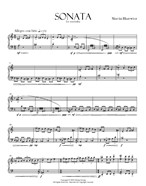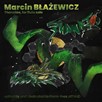
Sonata for Marimba
Composer: Marcin Blazewicz
Instrument: Marimba
Level: Advanced
Published: 2009
Price: €16.00
Item details
-
Description +
-
Duration: 7 min.
Some thirty years ago the marimba was still an instrument which was of no interest for composers. In recent years, however, the technique of playing this instrument has greatly developed. The instrument itself has also undergone certain changes. The modern development of the technical and expressive abilities of the marimba resembles the development of the grand piano at the beginning of the 19th century. Nowadays, it provides huge possibilities for the composer’s imagination from the technical, as well as expressive point of view (tone colours, dynamics, articulation, etc.). For quite a long time now I have been of the opinion that the marimba may serve as means of expression just as well as classical concert instruments. This is how I felt about the marimba when I was writing concertos for this instrument, and it was this idea that motivated me when I was composing this sonata.
This composition consists of one part only, and displays many features of a sonata-allegro. The germ of the first theme appears right at the beginning of the composition and is folk in nature. This folk character arises more from the rhythmicity which is typical for the Polish mazurka or kouiaviak than from the melodic line. The germ nature of the theme is due to the fact that it never appears in its entirety. It is always incomplete to a certain extent. The second theme, which contrasts with the first one, appears in the 60th bar and is a kind of an oneiric waltz. The thematic layer, consisting of the two themes and the musical material that appears in between (melodic pattern, rhythm, harmony, texture, etc.), constitute the substance that is processed in various ways in the subsequent part of the composition.
An important factor in the composition is building emotions. In the sonata there are a few different – as far as their intensity is concerned – emotional climaxes. The first one is discernible in bars 148-151. The second one, which is much stronger, appears in bars 230-232. After them there is a short slower episode, the aim of which is to calm the emotions and create a basis for the escalations that are to follow. The third climax is quite a long ascending plane (bars 254-304). It is internally divided into three sections, each of which carries ever stronger emotional tension (254-264,265-272, 273-304). The acme is reached in bars 305-307. The last emotional climax, which is a coda, is bars 354-356.
In the sonata I avail myself of various technical means, the full catalogue of which is easily discernible even after a cursory reading of the score. However, each and every of those means is subordinated to the superior aim, which is the expressive and emotional power of the composition. All ossias serve as technical measures facilitating the performance of the composition.
-
-
Instrumentation +
-
Marimba (5-octave)
-
-
Watch+
-
About the composer +
-
Composer and teacher. Born in Warsaw in 1953. He began to study music when he was 13 years old, first at the Oskar Kolberg primary Music School then at the F. Chopin Secondary Music School (double bass). Upon passing his secondary school leaving examination (matura) he studied natural philosophy at the Academy of Catholic Theology for one year (1975/76). Upon graduating from secondary music school in 1977 he began to study at the Department of Composition, Conducting and Theory of Music at the Fryderyk Chopin Academy of Music in Warsaw in Professor Marian Borkowski's class of composition which he finished with honours (1977-1982). He attended composer courses led by François Bernard Mâche (Pécs, Hungary 1980) and Yannis Xenakis (Salzburg, Delft 1985), obtained a SACEM scholarship from Sociéte des Compositeurs et Editeurs de Musique (France) and, as holder of an Acanthes scholarship, he attended a course in composition led by Olivier Messiaen in Avignon (France) in 1987.
Professor Marcin Błażewicz has been a member of the faculty of the AMFC in Warsaw since 1985, first as assistant then tutor (1996-2003) and finally as associate professor at the Chair of Composition. He teaches the following subjects: score reading and introduction to composition and instrumentation (his main interest). He has supervised many master's theses. He was deputy dean of FCUM Department I in 1999-2002 and 2005-2008. In 2008 he was elected dean of the Department of Composition, Conducting and Theory of Music for term 2008-2012.
Marcin Błażewicz presented a paper "On the situation in Polish Music after 1989" at the 5th Biennial "La recherche musicale en Europa" (Gif-sur-Yvette, France 1992). He has organised more than 200 concerts propagating contemporary music including several cycles: Presentation of Young Composers, Encounters with Contemporary Music, Young Musicians for Young Audiences (Warsaw 1979-81). Artistic director and founder of the International New Music Forum festival (Warsaw 1983-87), artistic director of the International Festival "Jeunesses Musicales" (Częstochowa, 1986, Warsaw 1990). Co-founder of the Modus group (1983), music advisor to the French Institute in Warsaw (1985-86). Member of the jury of the International Radio Festival Prix Italia (Peruggia 1989). Musical director of the Polish Radio Theatre (1986-97). Editor-in-chief of the journal "Muzyka21" (2000-2001). Since 2005 he has been holding a class of composition in Fryderyk Chopin University of Music/ FCUM/.
-
-
Reviews +
-
Review (Percussive Notes, July 2012)
Technically challenging and musically energetic, this new work is destined to quickly become a staple of standard marimba repertoire. Having already been recorded professionally on numerous occasions since its publication in 2009, this work speaks to the technical demands of the modern marimbist while engaging a diverse concert audience. Approximately eight minutes in length, it neither sacrifices musicality for empty virtuosity nor neglects sophistication in the interest of accessibility.
The composer uses thematic material that maintains a strong Polish folk music quality. This is often subjected to transpositions, chromatic embellishments, and rhythmic variations as the piece develops. The use of tuneful themes and ideas, subjected to such devious compositional twists and turns, is a large part of what allows this piece to seem both technically sophisticated and musically delightful at the same time.
The performer must be comfortable with one-handed octaves in both hands over the entire range of the marimba; it is this technique that the composer capitalizes on to invoke the full soloistic potential of the instrument. However, recognizing some of the challenges imposed by the range of the instrument being covered, the composer also includes several alternative suggestions to make certain passages more playable. While many marimbists will surely be enticed by such technical hurdles, they must never lose sight of the sensitivity needed to express the simple folk-like charm contained in much of the music.
—Jason Baker
-
-
Credits +
-
Front Cover artist: Marta Paulat
Front Cover graphics and layout: Ronni Kot Wenzell
Dedicated to Johan Svitzer
Engraving: Johan Svitzer
Printed in Copenhagen, Denmark
Copyright © Edition Svitzer
www.editionsvitzer.com
-


